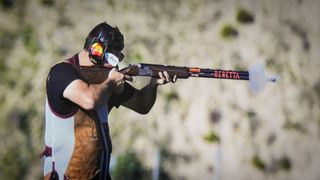
Our top picks
1. Best standard zoom
2. Best standard prime
3. Best telephoto zoom
4. Best affordable standard zoom
5. Best portrait lens
6. Best super-telephoto zoom
7. Best lens for travel
8. Best ultra-wide prime
9. Best ultra-wide zoom
10. Best for street photography
11. Best macro lens
12. Best APS-C wide zoom
13. Best APS-C wide prime
14. Best APS-C telephoto zoom
15. Best value APS-C prime
How we test
FAQs
We’ve always been big fans of Sony’s top-flight G Master lenses. They’re big and beautiful, but expensive, designed to suit the best Sony cameras for professionals. These lenses aim for the ultimate in all-around performance and image quality, especially in terms of sharpness and bokeh (the quality of defocused areas within images). But they’re not for everyone. We’re finding more and more that we need to keep an eye on the budget, and there are many relatively affordable lenses that we’d be more than happy to pop in our kit bags.
We’re also impressed that, because Sony stole a lead on other manufacturers in the full-frame mirrorless market, it’s had more time to build up a wide array of companion lenses to suit every need and budget. And let’s not forget that there’s a deep vein of history behind Sony's range of APS-C models that are more for hobbyists and enthusiasts, like the Sony A6400 or the Sony ZV-E10 vlogging camera.
As with other camera systems, you can use full-frame ‘FE’ lenses on APS-C models too, and often this can be the best choice for telephotos, macro lenses, and other longer focal length options. But with standard zooms and ultra-wide lenses, we always feel it’s essential to get the right tool for the job, which will be a lens specifically designed for an APS-C format camera. And, if you haven't decided which model to buy, then do also check out our best Sony camera guide.
So, without further ado, here are the lenses that we think are the best buys in all the major categories, for both full-frame and APS-C format Sony mirrorless cameras.
Best Sony Lenses: Our Top Picks
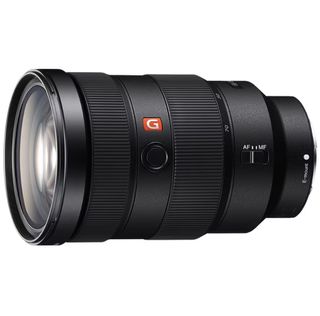
For us, a ‘trinity’ standard zoom lens with a fast and constant F2.8 aperture is the go-to lens for everyday shooting, and the FE 24-70mm F2.8 GM II is one of the finest examples of the breed. Read more below...

We always think that a ‘nifty fifty’ is an essential bit of kit. The Sony FE 50mm F1.4 is the lens that is most suited to most Sony shooters who love the natural perspective of a 50mm prime. It's light and compact, without compromising on optical quality. Read more below...

We’ve always found a 70-200mm F2.8 lens to be arguably the most essential zoom, even for those that generally shoot with primes, and the Sony FE 70-200mm F2.8 G Master OSS is a seriously top-flight option. Read more below...
Best Sony lenses in 2023
Why you can trust Digital Camera World Our expert reviewers spend hours testing and comparing products and services so you can choose the best for you. Find out how we test.
Best Sony standard zoom lens
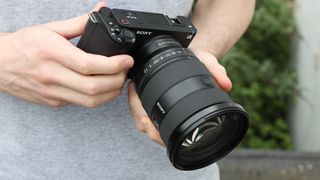
For us, a ‘trinity’ standard zoom lens with a fast and constant F2.8 aperture is the go-to lens for everyday shooting, and the FE 24-70mm F2.8 GM II is one of the finest examples of the breed. We really like the sturdy, weather-sealed build quality and handling characteristics, with its customizable focus hold function button and switches for AFMF and zoom lock.
The lens is packed with high-tech, high-precision optical elements, and we love that autofocus is blazing fast for stills and provides smooth and near-silent autofocus transitions during movie capture. There’s no optical stabilizer but this is only an issue with first-edition Sony mirrorless full-frame cameras that lack in-body stabilization.
Image quality is spectacular in all respects. Even when shooting wide-open, we’ve found that sharpness is simply phenomenal, throughout the entire zoom range. But if your pockets aren’t deep enough for such an expensive lens, other strong contenders include the Sigma 24-70mm F2.8 DG DN Art, Tamron 28-75mm F2.8 Di III RXD G2, and Samyang AF 24-70mm F2.8 FE.
Read our full Sony FE 24-70mm f/2.8 GM II review for more details
Best Sony standard prime lens
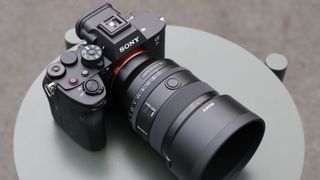
We always think that a ‘nifty fifty’ is an essential bit of kit. The Sony FE 50mm F1.4 is the lens that is most suited to most Sony shooters who love the natural perspective of a 50mm prime.
Impressively light and compact, but not compromising one bit on optical quality, we find this lens is pretty much perfect when it comes to center-sharpness and holds up very well towards the edges of the frame. If you don't really feel the need for the even faster aperture, added size, weight, and considerable extra cost of the Sony FE 50mm F1.2 G Master, then this FE 50mm F1.4 is the one to go for.
Read our full Sony FE 50mm f/1.4 GM review for more details
Best Sony telephoto zoom lens

We’ve always found a 70-200mm F2.8 lens to be arguably the most essential zoom, even for those that generally shoot with primes, and the Sony FE 70-200mm F2.8 G Master OSS is a seriously top-flight option.
We’re impressed that the feast of glass includes a double-sided XA (Extreme Aspherical) element, two other aspherical elements, four ED (Extra-low Dispersion) elements, and two Super ED elements. For tracking action, we also love the super-fast autofocus system, based on dual linear motors plus an RDSSM (Ring Drive Super Sonic wave Motor).
Handling is refined, with an autofocus range limiter, customizable focus hold buttons, and dual-mode stabilization for static and panning shots. For a more lightweight option, we also love the compact Tamron 70-180mm F2.8 Di III VXD, while the Tamron 70-300mm F4.5-6.3 Di III RXD is a more conventional ‘budget’ telephoto zoom.
Read our full Sony FE 70-200mm f/2.8 GM OSS review for more details
Best affordable Sony standard zoom lens

There is an older Sony Vario-Tessar T E 16-70mm F4 ZA OSS which is cheaper and lighter than this lens and has optical stabilization, but the maximum aperture is F4, so the new Sony E 16-55mm F2.8 G is, we think, the best standard zoom for Sony APS-C cameras. As a standard lens with a classic zoom range, the Sony E 16-55mm F2.8 G ticks nearly all the right boxes.
It delivers sumptuous image quality with fabulous sharpness and contrast, along with pleasant bokeh. Handling is very refined, with the addition of a customizable focus hold button, strong build quality, and weather seals. Autofocus is super-fast and deadly accurate. The only downside is the lack of optical stabilization but, overall, we simply love this lens.
Read our full Sony E 16-55mm f/2.8 G review for more details
Best Sony portrait lens

While the Sony FE 85mm F1.4 G Master will be seen as the most ideal portrait lens by many, we find that this 135mm version gets us closer to your sitter while maintaining a natural shooting distance, thus working really well for close-up portraits, and any other shooting scenario that calls for impeccable image quality at this focal length.
The high-grade optical path includes XA (eXtreme Aspherical), Super ED, and regular ED elements, along with an 11-blade diaphragm that maintains a particularly well-rounded aperture when stopping down a bit.
We love the handling, complete with an aperture control ring with de-click switch, and the lens combines striking sharpness and contrast with a really smooth bokeh. A cut-price but highly capable direct competitor is the Samyang AF 135mm F1.8 FE, and it’s also worth considering the Sigma 85mm F1.4 DG DN Art and the specialist Sony FE 100mm F2.8 STF G Master OSS.
Read our full Sony FE 135mm f1.8 GM full review for more details
Best Sony super-telephoto zoom lens
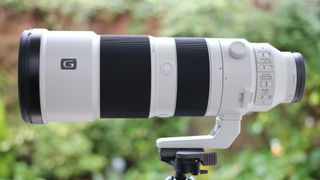
Fast super-telephoto lenses for full-frame cameras are always expensive, but we like that the more modest aperture rating of the Sony FE 200-600mm F5.6-6.3 G OSS makes it relatively affordable. We think this lens has a real wow factor. Sure, it’s not a G Master optic but it looks and handles great.
It’s naturally pretty big and heavy but entirely viable for handheld shooting, helped along by effective Optical SteadyShot. We’re also impressed by the fast autofocus system, which is adept at tracking fast-paced action in action, sports, and wildlife photography, for which the lens is ideal. All in all, it delivers sharp shots time after time, with an excellent hit rate.
Read our full Sony FE 200-600mm f/5.6-6.3 G OSS review for more details
Best Sony lens for travel
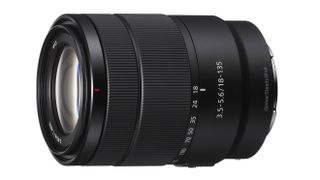
We like to travel light. Whether we’re exploring city streets or venturing further afield, we often like to stick to one lens that caters to wide-ranging shooting scenarios. And that’s why we really rate the Sony E 18-135mm F3.5-5.6 OSS.
It's compact, neat, affordable, and offers a really useful zoom range. And unlike many ‘superzoom’ lenses, it delivers impressively sharp shots throughout its entire zoom range. Sure, it relies quite heavily on in-camera corrections for various aberrations, but that’s par for the course with many recently designed lenses for mirrorless cameras.
Read our full Sony E 18-135mm F3.5-5.6 OSS review for more details
Best Sony ultra-wide prime lens
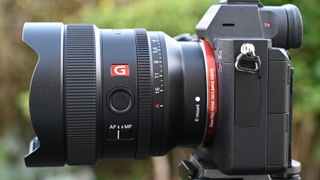
We think the Sony FE 14mm F1.8 G Master is a real gem of a lens. It’s surprisingly compact and lightweight for an ultra-wide-angle, full-frame compatible lens with such a fast aperture rating. Even so, there are no compromises in terms of build quality, refined handling characteristics, and all-round performance.
In our tests, we’ve always found that image quality is simply stellar. Indeed, the lens takes sweeping landscapes in its stride, it’s epic for cityscapes and it scintillates when the stars come out at night. It’s undeniably pricey but worth every cent. If you’d prefer a less ultra-wide viewing angle, also consider the Sony FE 20mm F1.8 G and Sigma 20mm F2 DG DN | C.
Read our full Sony FE 14mm F1.8 G Master review for more details
Best Sony ultra-wide zoom lens
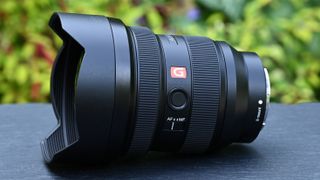
Completing the trinity of F2.8 constant-aperture zooms, the FE 12-24mm F2.8 G Master hits the wide-angle spot. We love that this lens actually goes wider than many competitors, delivering a really extreme maximum field of view. Moreover, it maintains superb image quality and all-round performance throughout its entire zoom range, earning its G Master credentials.
Even so, we wouldn’t rule out the Sony FE 12-24mm F4 G zoom, which gives the same ultra-wide viewing angles but is an f/stop slower. And if you don’t feel the need to go so ‘ultra-wide’, the Tamron 17-28mm F2.8 Di III RXD is an excellent budget-friendly alternative.
Read our full Sony FE 12-24mm f/2.8 G Master review for more details
Best Sony lens for street photography

We tend to favor a 35mm prime lens for street photography and this one is fast and extremely capable. It’s a premium G Master option that gives a mix of an ultra-fast maximum aperture and modest wide-angle focal length, making it a very versatile lens not just for street photography, but also for anything from portraits and weddings, to landscape and astrophotography.
As you'd expect, it isn't cheap, but it impresses us with its spectacular optical performance. It's not the smallest 35mm prime we've seen, but it has great handling, with a perfectly weighted ‘de-clickable’ aperture ring and super-smooth focus ring. A lovely lens, but it inevitably comes at a hefty price. For candid street photography or if you’re on a tighter budget, consider the Sony FE 40mm F2.5 G.
Read our full Sony FE 35mm f/1.4 G Master review for more details
Best Sony macro lens
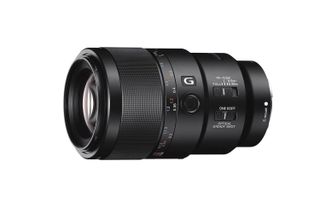
There’s a lot to love about this macro lens. We find that its minimum focus distance of 0.28m gives a very natural working distance for full 1.0x or 1:1 macro magnification.
Beautifully built, this lens has up-market handling attractions including a customizable focus hold button, autofocus range limiter switch and Optical SteadyShot. Given that manual focusing is often preferred for extreme close-up shooting, there’s also a handy push-pull mechanism in the focus ring, for switching between auto and manual focus modes.
We find that image quality is very good in all respects, with excellent sharpness even wide-open at F2.8, and the edges and corners catch up nicely when stopping down a little. More importantly for a macro lens, sharpness remains very good at narrow apertures, often required to get more than a tiny depth of field.
Read our full Sony FE 90mm f/2.8 Macro G OSS review for more details
Best Sony APS-C wide zoom lens
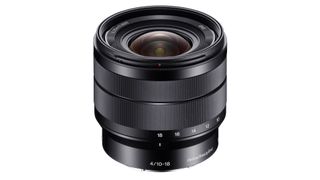
We like that this ultra-wide-angle zoom for APS-C cameras is conveniently compact and lightweight, yet still packs a real punch with good overall performance, a constant F4 aperture rating throughout the zoom range, and 3-stop optical stabilization. The latter is quite rare on an ultra-wide-angle zoom lens, and very useful if you have one of Sony's un-stabilized A6000-series cameras.
In terms of image quality, center-sharpness is excellent throughout the zoom range but corner-sharpness is relatively lackluster at 10mm, even when stopping down the aperture.
Thankfully, color fringing is pretty negligible at any combination of focal length and aperture setting, even towards the corners of the image frame, and distortion is quite well controlled. If you’re more into video shooting and vlogging than stills photography, a better bet is the newer Sony E PZ 10-20mm F4 G, with its motorized zoom mechanism.
Read our full Sony E 10-18mm F4 OSS review for more details
Best Sony APS-C wide prime lens
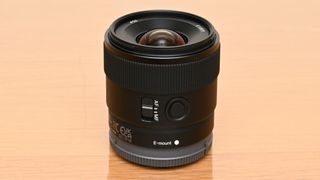
The fact that this compact and lightweight ultra-wide-angle prime feels such a natural fit on Sony’s slimline APS-C format cameras is something that we really liked, as soon as we started using it.
With its ‘effective’ focal length of just over 15mm and a viewing angle of 104 degrees, we’ve found it to be a highly versatile lens that’s ideal for landscapes, cityscapes, shooting interiors, and for vlogging. The handling is really nice and the build quality feels solid, complete with weather-seals. If you would rather have a rather more moderate viewing angle with a faster aperture, check out the Sony E 15mm F1.4 G.
Read our full Sony E 11mm F1.8 review for more details
Best Sony APS-C telephoto zoom lens

We absolutely love the Sony E 70-350mm F4.5-6.3 G OSS. It sports a 5x zoom range that equates to 105-525mm in full-frame terms, taking it into super-telephoto territory, but with a comparatively compact and lightweight build. Downsizing is helped by the modest F4.5-6.3 aperture rating but image quality and all-round performance are very impressive.
It doesn’t have the world’s most effective optical stabilizer, but you can still expect a great hit rate with sharp handheld shots, even at the longest zoom setting. Overall, this is a lens that’s big on performance but refreshingly small and lightweight for handheld shooting.
Read our full Sony E 70-350mm f/4.5-6.3 G OSS review for more details
Best value APS-C prime for Sony

We’re admirers of this Viltrox 23mm lens, plus the 33mm and 56mm editions. All three are a virtually identical size and weight, giving ‘effective’ focal lengths of around 35mm, 50mm, and 85mm on APS-C cameras. They all boast a fast F1.4 aperture rating and we like that they come complete with an aperture control ring, which is de-clicked making it ideal for video as well as for stills.
Autofocus is fast and accurate, and we love the image quality that these lenses deliver, in terms of bokeh as well as sharpness and contrast. The lenses are great value at the price, undercutting the also desirable Sigma f/1.4 DC DN | C 16mm, 30mm, and 56mm competitors.
Read our full Viltrox AF 23mm F1.4 review for more details
How we test Sony lenses
We test lenses using both real world sample images and lab tests. Our lab tests are carried out scientifically in controlled conditions using the Imatest testing suite, which consists of custom charts and analysis software that measures resolution in line widths/picture height, a measurement widely used in lens and camera testing. We find the combination of lab and real-word testing works best, as each reveals different qualities and characteristics. You can find out more about how we test and review on Digital Camera World.
FAQs
Do I need OSS?
Optical SteadyShot can be really useful if your Sony camera doesn’t feature IBIS (In-Body Image Stabilization). It’ll help counteract the effects of camera-shake and ensure you get sharp handheld shots more consistently with slow shutter speeds. IBIS tends to be less effective when shooting with telephoto lenses, so OSS is often featured in this type of lens regardless.
What’s the APS-C crop factor?
Sony’s APS-C cameras have an image sensor that’s the same size as a frame of ‘Advanced Photographic System type C’ film. That’s somewhat smaller than a frame of 35m film, on which full-frame digital cameras are based. The outcome is that the ‘crop factor’ gives a 1.5x magnification in the focal length of lenses. For example, a 50mm lens will give the same field of view as using a 75mm lens on a full-frame camera.
How do I tell if a lens is full-frame compatible?
It can be tricky for the uninitiated to recognize the difference between Sony lenses that are made for full-frame or APS-C format cameras. The clue is in the title. APS-C format lenses have an ‘E’ prefix, whereas full-frame compatible lenses have an ‘FE’ prefix. Bear in mind though, that you can shoot with E lenses on full-frame cameras in crop mode, and with FE lenses on APS-C cameras with no limitations.
Zoom or prime?
Sometimes it’s hard to decide whether a zoom lens or a prime lens will be a better buy. Zoom lenses tend to be more versatile, as they cover a broad spread of focal lengths. However, there’s a lot to be said for the prime lenses, which generally have a wider or ‘faster’ aperture rating and are often relatively small and lightweight. 35mm, 50mm and 85mm prime lenses are particularly popular for street photography, general shooting and portraiture, respectively.



